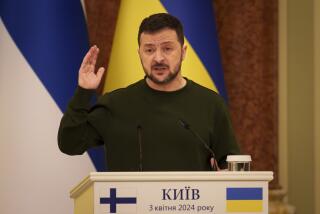Italy Arrests 2 Who Reportedly Spied for Soviets
- Share via
ROME — Authorities arrested two people on charges they tried to pass along top-secret NATO documents to the Soviet Union, including information on a new computer system designed to direct an entire battle, news reports said Sunday.
“It could be the biggest counterespionage operation in Europe in recent years,” Rome’s La Repubblica newspaper said.
Prosecutors and police confirmed that two people were arrested for espionage, but they refused to give details, saying the investigation is continuing.
The Italian news agency AGI said Sunday that the arrests ended two separate KGB operations in Italy.
The reports about the affair, carried by newspapers and the state-run RAI television network, identified the two men arrested as Giorgio Stancich, 42, an electronics technician living in Yugoslavia, and Natalino Francalanci, 51, a fur dealer from Pontedera, near Pisa.
Francalanci was arrested Feb. 11 in the port city of La Spezia, the site of a naval base. Stancich, 42, was arrested Thursday near the Adriatic port of Trieste, the reports said.
RAI said that Francalanci, who traveled often to Eastern Europe on business, was arrested in connection with North Atlantic Treaty Organization research on anti-submarine warfare.
The AGI news agency went further, reporting that Francalanci was linked to an alleged Soviet effort to procure information about the making of fiber optics for industry and the military.
It said that the KGB was seeking to obtain information on the technology used by Otomelara, a La Spezia firm that makes fiber optics. Italian agents discovered that Francalanci and another, unidentified man had been bringing information about the technology to the KGB in Vienna. The second man has fled the country, the agency added.
Stancich was arrested while trying to cross the border with documents related to a highly advanced electronic warfare project known as Catrin, said to be one of the most sophisticated systems of its kind and destined for use by NATO.
The project, still under development, involves computer systems for directing battlefield activity, including ground and air operations, the news reports said.
More to Read
Sign up for Essential California
The most important California stories and recommendations in your inbox every morning.
You may occasionally receive promotional content from the Los Angeles Times.









